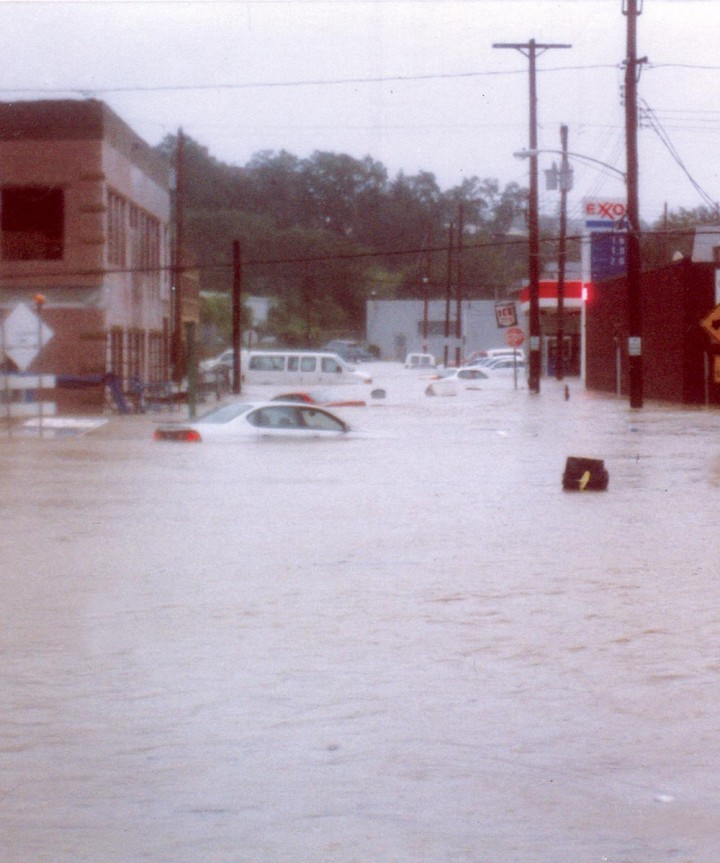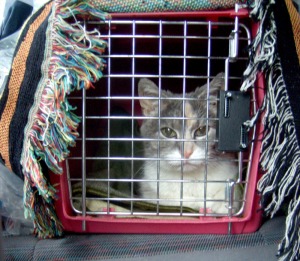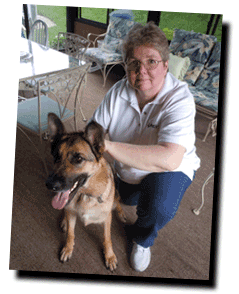Are Your Pets Prepared for an Emergency?

by Karen Sable, Guest Columnist
June marks the beginning of the Atlantic Hurricane season bringing some of the most dangerous and destructive weather we experience in North America. In addition, early and mid-summer storms often breed unexpected tornadoes and microbursts with only minutes of warning to take shelter.
With that in mind, this is a timely opportunity to ask yourself if you have a good Emergency/Disaster Plan for your family which includes any pets you may have.
If you had to quickly evacuate your home, and possibly be unable to return for an extended period, do you have a “Go Kit” stocked and ready for you and your pets that would enable you to be self-sufficient for at least 5-7 days? Do you know where you could/would go with your pets ? If you lost all power and were unable to leave your home for some time (remember “Snowmageddon” ), would you and your pets have enough food, water, medications, and other supplies to be able to wait out the emergency? If you were not at home when an emergency occurred, or were unable to get home for some reason, have you made arrangements with someone who would be able to get to and care for your pets? These are all questions you need to answer before an emergency or disaster happens!
Disasters aren’t just a weather condition, however
When you hear the word disaster or emergency, you may immediately think about the kind of natural disasters you see on TV, like tornados, hurricanes, earthquakes, wildfires, and major flooding. But emergencies that may require evacuation, that may prevent you from getting home, or that may strand you inside your home, aren’t just limited to big natural disasters. Think about what you and your pets would do if:
- A construction crew digging in the area ruptures a large gas line, or a train carrying a toxic substance derails on nearby tracks, and your neighborhood must immediately be evacuated;
- There’s an explosion in a nearby gas well, factory, or power plant and the Fire Dept. comes knocking at your door and orders you to leave;
- A sudden storm hits while you are at work, flooding and closing roads, and making it impossible for you to get home to let your dog out, feed the cats, or give them needed medication;
- A major snow/ice storm hits, knocking out power, and making the roads impassible. It may be days before power is restored or you can leave your home.
Make your plan ahead of time
If you had to evacuate with your pets, shelter at home for some period, or provide for your pet’s safety and care in your absence, do you have a plan in place? At the end of this article we’ve provided a checklist for you to download and keep in a handy place so that you can organize your materials and contact information and have it available for others who may need to rescue your pets if you can’t get there.

The following recommendations and guidelines are intended to help pet parents prepare for an emergency or disaster so that if/when one occurs, you can greatly increase your pet’s chances of survival:
Arrange with a trusted neighbor, nearby friend, or family member to be responsible for your pet in case you are not home, or are not able to get home. Make sure they have the key to your house and are familiar with and comfortable with your pets. If evacuation is necessary, ensure that they are willing to take your pets, know the location of your pet carriers, crates, leashes, etc., as well as your pet emergency “go-kit.” Pre-arrange how/where you would meet, and exchange emergency contact information, including places where your pets would be welcome and could be temporarily sheltered .
Since evacuation shelters for people generally do not accept pets (except for service animals), you must plan ahead to make sure you know where your pets would have a safe place to stay once evacuated. While state and local governments are required to include companion animals in their emergency plans, that does not mean that any shelter provided for pets will be with or even near the human shelters. Could a friend or family member a safe distance away take in you and your pets? Research, locate, and make a list of any pet friendly hotels where you and your pets could go. In an emergency, some hotels which do not normally allow pets will waive their “no pets” policy, but you need to find that out ahead of time. Include on your list any boarding facilities, kennels, animal shelters, or veterinary offices/hospitals which could provide temporary shelter for your pets.
Make sure that your pet is wearing up-to-date identification information at all times. This includes listing not just your home phone number on their tag, but also your cell phone number, or even the number of a friend or relative outside of your area. If your pet were to become lost, you want to make sure that the contact number on their tag will be answered even if you are not at home.
The single most important thing you can do to ensure your pet’s safety is to take them with you if you must evacuate, even if you think you may only be gone a short time. As we learned during Hurricane Katrina, animals left behind can easily escape through broken windows or storm damaged portions of a home, and pets who get loose, or who are turned loose to fend for themselves, are likely to become victims of accidents, predators, starvation, contaminated food and water, and exposure. And simply leaving an animal tied or chained outside in a disaster is an almost certain death sentence! If it’s not safe for you to remain at home, it’s not safe for your pets!!

Have crates or carriers for all of your pets that are sturdy and able to be secured. Clearly print your name and contact information on the carrier in indelible ink. Cat carriers should be large enough to hold two small dishes and a small litter pan and still allow enough room for your cat to turn and lie down, and stand to use the litter box. Dog crates should be large enough to hold two no-spill bowls and allow room for your dog to stand, lie down, and turn around. Remember that your pet may have to stay in their carrier/crate for hours at a time while away from home or in an emergency pet shelter.
Have a Pet First Aid Kit available. You can buy one “ready made,” or make one up yourself, but make sure you know what is in your kit and how to properly use it. Taking a Pet CPR and First Aid Class from a qualified Instructor will give you the skills and knowledge to handle medical emergencies with your pet prior to getting them Veterinary care.
In addition to emergency supplies for you and your family, be sure to have an evacuation kit for your pet ( your pet’s “Go Kit” ) stocked and kept in a handy location. Be sure to periodically check any items with expiration dates (especially food and medications) and replace as necessary. Everything you need can be stored in a plastic storage container or even a duffle bag. At a minimum you need:
- a 5-7 day supply of water
- a 5-7 day supply of food (canned and dry), and instructions re; amount and type of food for each pet, feeding schedule, and what NOT to feed in case of allergies
- a 5-7 day supply of any medication your pet needs (with instructions for each animal indicating dose and frequency for each medication, and contact info for vet and pharmacy for refills)
- manual can opener
- spoon (for canned food)
- copies of current vet records & proof of ownership (in a water tight zip lock bag)
- picture of your pet (preferably you & your pet together)
- no-spill food and water dishes
- litter pan, litter scoop, and litter (enough for 5-7 days)
- your pet’s favorite toys, blankets, etc.
- your pet first aid kit
- emergency contact list
- leash and collar or harness for each pet
- paper towels
- trash bags
- grooming items
- pet cleaning wipes or dry shampoo
- dish soap (Dawn)
- bleach (for cleaning up spills and pet’s “accidents”)

Download your checklist and be prepared
Click here or on the little icon at right in order to download this checklist as a PDF file.
Your pets rely entirely on you for their safety and well being. In an emergency or disaster, your actions may well make the difference in their survival. As a loving, responsible pet parent, make sure you, and they, are prepared.

About Karen Sable
Karen Sable, owner of Pet Emergency Training, LLC, completed the Pet Tech Instructor program in March, 2011 and teaches pet first aid classes in the Pittsburgh area. Karen is a trained responder with several national animal response/rescue teams, including American Humane’s Red Star Animal Emergency Services Team, United Animal Nations’ Emergency Animal Rescue Service, and Noah’s Wish Disaster Response Team. She is also a member of the PA/Allegheny County and Westmoreland County Animal Response teams, and a volunteer animal rescue transporter and recently earned a training certification in Water Rescue.
In addition to having a Veterinary Assistant diploma, Karen’s training certifications include Emergency Animal Sheltering, Large Animal Rescue, Animals in Disaster, Livestock in Disaster, Hazardous Materials, Incident Command and National Incident Management. As a former healthcare Human Resources Director, Karen now devotes her extensive training experience, and love of animals, to teaching pet care professionals and fellow pet parents the skills and knowledge that can save their pets and improve the quality of their pets’ lives. Visit her website at Pet Emergency Training, LLC.
An article on a timely pet first aid and disaster rescue topic will appear on The Creative Cat on the first Friday of every month. Read more about Karen in The Creative Cat Welcomes Guest Columnist Karen Sable.
Nominate The Creative Cat for an award and help to win $1,000 cash for the Homeless Cat Management Team and $10,000 for the shelter or rescue of your choice!
The URL of The Creative Cat is: https://thecreativecat.net/
Click here or on the logo below to go to Dogtime’s Petties 2012.
All images used on this site are copyrighted to Bernadette E. Kazmarski unless otherwise noted and may not be used without my written permission. Please ask if you are interested in purchasing one as a print, or to use in a print or internet publication.



Pingback: “Your Pets Health: It’s Time to Talk about Organizing” | K9 Links Resource
Fantastic – and very important information! Great guest post! And we might add that if your cats are like ours and they have a fit when the carrier comes out, we’ve found a ‘pop up” dog carrier that will hold all three! might be a bit awkward carrying, but it’s better than racing thru a burning house trying to corral kitties! We have the pop up carrier next to the 3 individual ones in the front hall closet, with our emergency kit.
Lisa, thank you! You’re the second person who’s mentioned fire too, and being prepared for that is important too, especially in a multi-cat household. I have carriers all over the place!
This is important for every pet info for every pet household to have. I’d like to add there should be individual carriers for each pet for quick evacuation like a house fire.
Layla, yes, household preparedness is a whole other topic, especially house fires. There isn’t much I’m more frightened of than a house fire…
Thank you for this invaluable information. I live in Florida and hurricane season is approaching. But I found it especially important to note that emergencies are not contingent on disasters and could happen at any time. Very good post.
Deb, sometimes I don’t know how you live in such a weather-disaster-prone area. We aren’t so prone to weather disasters here in western PA, but industrial incidents are all too common–derailments, chemical spills, industrial emissions. I actually passed on a nice little house in the country because it was too close to an active rail line and I was too worried about what would happen to my cats if there was a derailment while I was at work.